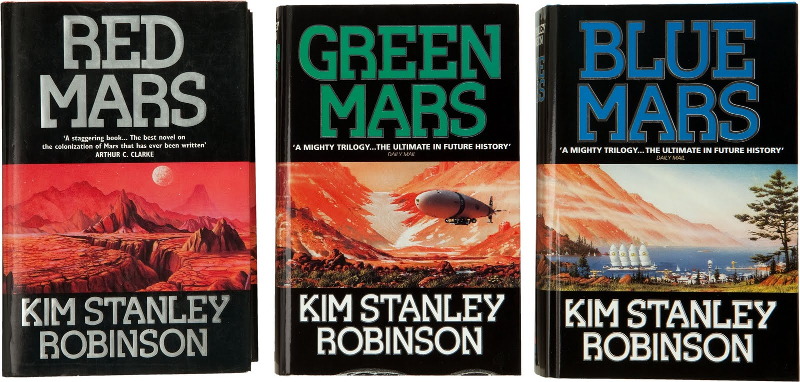Blue Mars
Kim Stanley Robinson, VOYAGER £15.99, Hbk.
Red Mars, Green Mars
VOYAGER both £5.99, Pbk.
As Mars is terraformed, its dusty red surface shifts through the green of vegetation to the blue of ocean waves as its north polar ice cap is melted – the three volumes in Kim Stanley Robinson’s trilogy being named accordingly. Although Blue Mars can be read alone, it not only continues on from where the second book left off (the Terran flood disaster of 2127 and subsequent Martian bid for independence) but contains so many references to what has gone before that one can get far more out of Blue Mars if its read following the two preceding volumes. For instance, the opening crisis as to whether the radical terrorists should or should not destroy the (second) cable elevator link with the asteroid New Clarke relates to a whole prior history, including the destruction of the original cable and the freeing of the first Clarke from orbit, with the spectacular and devastating collapse of miles and miles of cable furnishing the unforgettable finale of Red Mars.
Not that the Mars trilogy is purely for techno-geeks. Principle characters are members of 2027’s original group of settlers, appropriately named the First Hundred even though their number also includes a hidden hundred and first member, a concealed stowaway later nicknamed Coyote. Scientists hand-picked by authorities on Earth, these include John Boone (the first man on Mars in 2019), his jealous, scheming colleague Frank Chalmers and volatile Russian sex bomb Maya, who comes between them; machine-repairing genius Nadia and secretive Japanese farming expert Hiroko, the terraforming master-planner Sax Russell and his loner geologist opponent Ann Clayborne.
Robinson subdivides his volumes into sections running from a handful to a hundred pages, each based around single characters some of whom die shortly after while others survive the entire trilogy. Those dead – or presumed dead – frequently crop up to haunt the living. Red Mars’ opening flash forward to assassination of John Boone fits chronologically into about the middle of that first volume, but affects everything that comes after, most notably the surviving dozen First Hundred’s reactions to 2211’s fading memory treatments towards Blue Mars’ finale. At three times 700 pages, the trilogy’s sheer volume is daunting, but the whole is so compellingly written that the effort more than pays off.
Review originally published in What’s On In Birmingham, 1996.
